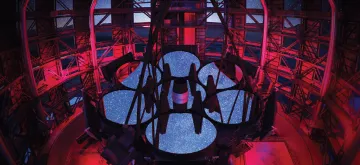
Artist’s rendering of the interior of a reflecting telescope at night.
Giant Magellan Telescope – GMTO Corporation
With computer modeling and an innovative polishing process, the University of Arizona is creating mirrors for the Giant Magellan Telescope (GMT) with remarkable speed and accuracy. When operational in 2029, GMT will be the most powerful optical telescope on Earth, able to detect Earth-like planets orbiting distant stars.
Reflecting telescopes deliver views of the universe using mirrors to gather light. While emerging technologies are expanding the ways scientists can process and analyze that light, one inalterable fact of optics remains: the larger and smoother the mirrors, the more powerful the scope.
Driven by that principle, a team of U of A scientists is creating GMT’s seven mirrors at nanometer-level accuracy. Together, the mirrors will form a light-collecting area of nearly 3,700 square feet, producing images at 10 times the resolution of the Hubble Space Telescope.
As part of the project, U of A faculty invented a technology to achieve unprecedented exactness and efficiency. A balloon-like structure filled with a special fluid maintains uniform pressure and a precision fit between mirrors and polishing tools while simulation and modeling algorithms continually optimize the robotic polishing process.
The resulting surfaces have smoothness deviations of less than 20 nanometers – the equivalent of a flat area the size of the U.S. with no buildings, peaks or valleys greater than 2 millimeters. In addition to optical views piercing farther into space than ever before, the team is also delivering giant time and cost savings, trimming a process that once took nearly a year to just over 90 days.
